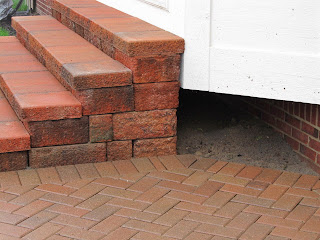Repair to Paver Patios & Paver Steps requires more expertise than using a Handyman
 Recently we did a paver patio and step repair in Ypsilanti. I could not understand why the customer was so ecstatic to see us arrive. The reason he was so glad to see us was our brick paver industry appropriate trucks, tools, and experienced crew. I do believe customer's are always happy when we come but this time it seemed exceptional.
Recently we did a paver patio and step repair in Ypsilanti. I could not understand why the customer was so ecstatic to see us arrive. The reason he was so glad to see us was our brick paver industry appropriate trucks, tools, and experienced crew. I do believe customer's are always happy when we come but this time it seemed exceptional. The homeowner informed me that he originally used one of those popular online Contractor Service referral sites. Upon their referral, he hired this "handyman" service company which was rated high by their online service. The homeowner was required to put down a 50% deposit one week prior to the repair services being performed.
When this handyman service company came to do the brick paver patio repairs, they pulled up in a van with ladders on top. They looked more prepared to install a light fixture than repair a pavers patio. They also did not have any wheel barrels, plate compactor, concrete pavers saw, or base material to raise the sunken areas.
 The most shocking event for the homeowner was that one of the handy men was carrying a crow bar. While the homeowner was speaking to the foreman, the other handy man was prying on the paver steps with this crow bar trying to break it apart. The homeowner was baffled by the foreman asking him what & how he wanted them to repair the sunken paver patio & step. The homeowner asked if they had all the necessary tools to perform this brick repair service and was told "we will get them as we need to". All the while, the other handy man was chipping & damaging the paver steps with this crude tire iron.
The most shocking event for the homeowner was that one of the handy men was carrying a crow bar. While the homeowner was speaking to the foreman, the other handy man was prying on the paver steps with this crow bar trying to break it apart. The homeowner was baffled by the foreman asking him what & how he wanted them to repair the sunken paver patio & step. The homeowner asked if they had all the necessary tools to perform this brick repair service and was told "we will get them as we need to". All the while, the other handy man was chipping & damaging the paver steps with this crude tire iron.The homeowner immediately asked them to stop and to refrain from performing this patio repair service. Upon better research, this homeowner contacted us for an opinion & estimate for repairing their interlocking paver patio. The shame of it was that our price was actually lower than the estimate from the handyman service company who did not even know what they were doing.
I am constantly contacted by these nationally known online contractor referral sites. The reason I do NOT participate is because they do not do a thorough job of screening businesses for particular repair work. Sure they make you supply the proper business & liability insurance and licensing ( if applicable) but they do not check out your quality of work or business practices. They are known for signing up "jack of all trades" contractors who do not specialize in the specific repair area they are referred too. Basically, if a contractor is willing to pay a fee for the referrals, they suddenly become a "qualified" and "reputable" business in your area.
You can easily do your own FREE local web search by putting in "brick paver repair (city you live in)" as the keyword phrase to get some local results. You sitll have to do your homework by checking out each estimator's references, insurance coverage, and licensing ( if applicable).




































